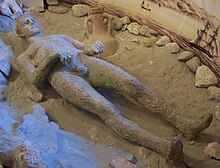Museum Kula
The Kula Museum (English: Museum The Tower ) in Veli Lošinj , Croatia, is named after a tower from the 15th century. It was established there in 2001. In addition to a permanent exhibition, it contains changing exhibitions by important Croatian and international artists.
On the history of the defense tower "Kula"
The Republic of Venice had Dalmatia in 1409 the Croatian-Hungarian King Ladislaus of Naples bought for 100,000 gold ducats. This marked the beginning of Venice's second reign over the Cres and Lošinj archipelago . In the course of the construction of defenses, a free-standing tower was built to protect Lošinj and the sea areas Lošinj and Cres, which, according to an inscription, was completed in 1455. This is a typical Renaissance tower with thick walls, built relatively low to protect against cannon fire and with the upper part of the walls sloping outwards so that attackers could easily be beaten. The parapet of the tower crown has changed the most over time.
The tower also served as protection against attacks from the Ottoman side and the Uskoks , but was obviously no longer required later and was left to decay. Restoration took place in 1774. After Austria-Hungary took control of the Kvarner Islands, it was no longer needed for defense. In 1911 the Kk Central Commission for Research and Conservation of Architectural Monuments in Vienna made an attempt to repair the walls, possibly on the recommendation of Archduke Karl Stephan , who at that time lived as an honorary citizen in Veli Lošinj and had taken over the patronage of the tower. But this did not affect the interior of the tower, so that the decay continued.
The last restoration to date began in 1997, financed by the city of Mali Lošinj and the Italian province of Venice . The roof structure and the inner beam construction were also renewed. At the same time, a concept for the design of the museum and gallery was developed. In 2000 the tower was open to the public again for the first time.
museum
The exhibition opened in 2001 covers 167 square meters on several floors. The permanent exhibition was conceived as a combination of thematic presentation and chronological presentation of the history of Veli Lošinj and its surroundings. The objects are described in Croatian and English. On the third floor there is a gallery that is used for changing art or historical-thematic exhibitions. Finally, you can enter the parapet of the tower and enjoy a panoramic view of the city and bay from there.
A special find is exhibited as a replica on the ground floor: an exceptionally well-preserved bronze statue of a Greek athlete (“ Croatian Apoxyomenos ”) found in 1996 between Veli Lošinj and the small island Vela Orjula at a depth of 45 m and recovered in 1999 . The original is exhibited in a specially set up museum in Mali Lošinj. The statue is dated to the first or second century BC. Dated. It is not known how the statue got into the sea. So far only four similar Greek bronze statues of this type have been discovered worldwide.
The first floor contains representations of the history of Veli Lošinj, from the development of the settlement to the rich shipbuilding and seafaring tradition to the development of spa facilities and today's tourism.
literature
- Museum-Gallery Exhibition Center Kula, Veli Lošinj: Guide to the permanent Exhibition. Adult education center, Museum-Gallery Department, Mali / Veli Lošinj 2005. ISBN 953-99919-1-9 (English)
Web links
Coordinates: 44 ° 31 '15.1 " N , 14 ° 30' 5.1" E

